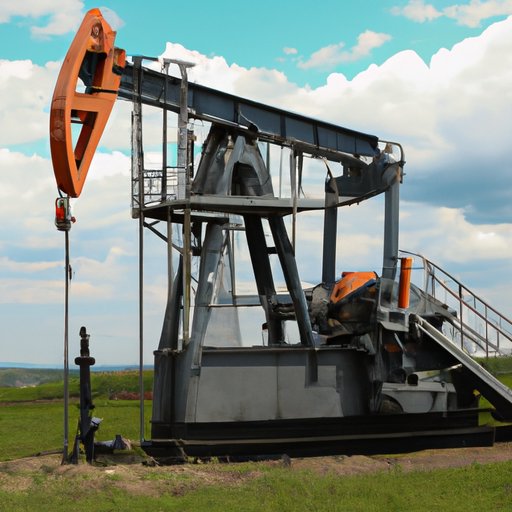Introduction
An oil well is a deep hole drilled in the earth’s surface by a rig in order to extract crude oil or natural gas from underground reservoirs. The process of drilling, completing, developing, and maintaining an oil well is complex and requires specialized equipment and personnel. This article will provide an overview of how oil wells work, including the different types of oil wells, the process of drilling and completing them, the techniques used to develop and maintain them, the environmental considerations, and the economic factors that affect their profitability.

The Different Types of Oil Wells
The oil and gas industry is divided into two main categories: exploration and production. Exploration involves locating potential sources of hydrocarbons (oil and gas) and assessing the viability of producing them. Production involves drilling, completing, and maintaining the oil well in order to produce the hydrocarbons.
Exploration is typically done using seismic surveys, which use sound waves to locate subsurface rock formations that may contain oil and gas. Once a potential site has been located, a drilling rig is brought in to begin the process of drilling the well. The type of well drilled will depend on the location and the type of hydrocarbon being sought.
Drilling and Completing an Oil Well
The drilling process begins with the construction of the wellhead and casing, which are devices that protect the borehole from collapse and contamination. The drill bit then begins to cut through the layers of rock until it reaches the reservoir. As the well is drilled deeper, additional casing is added and cemented in place to ensure the integrity of the wellbore.
Once the well reaches the reservoir, it is completed by installing production tubing and other necessary equipment. The production tubing is connected to the surface equipment, such as pumps and valves, which allow the oil and gas to be extracted. The well is then ready for production.

Developing and Maintaining an Oil Well
In order to maximize the production of oil and gas from the well, it must be developed and maintained properly. This involves various techniques and equipment, such as artificial lift systems, hydraulic fracturing, and chemical additives. Artificial lift systems use pumps to increase the pressure in the wellbore and force the hydrocarbons to the surface. Hydraulic fracturing is used to create fractures in the reservoir rock, allowing more oil and gas to flow out of the well. Chemical additives are also used to improve the efficiency of the production process.
In addition to these techniques, the well must be equipped with the proper safety equipment and monitored regularly to ensure its integrity. This includes blowout preventers, safety valves, and other devices that help prevent accidents and spills. Regular inspections and maintenance are also important to ensure that the well is operating optimally.
Environmental Considerations of Oil Wells
Oil wells can have a significant impact on the environment if not managed properly. Potential impacts include air and water pollution, habitat destruction, and noise pollution. In order to minimize these impacts, regulations and best practices must be followed. These include the use of best management practices to reduce waste and emissions, and proper disposal of any produced waters or other wastes.
In addition, operators must take steps to reduce the risk of spills and leaks. This includes using proper containment and spill prevention techniques, as well as monitoring and responding quickly to any potential problems.

The Economics of Oil Well Operations
The economics of oil well operations are affected by a variety of factors, including the cost of drilling and completion, the price of the hydrocarbons, and the rate of production. The cost of drilling and completing an oil well can vary significantly depending on the size and complexity of the project. The price of the hydrocarbons is determined by market forces, and can fluctuate over time. Finally, the rate of production can vary depending on the size of the reservoir and the efficiency of the production process.
In order to maximize the profitability of an oil well, operators must carefully manage the costs associated with drilling and completing the well, as well as the production process. Operators must also monitor the market conditions and adjust their operations accordingly in order to maximize profits.
Conclusion
This article provided an overview of how oil wells work, including the different types of oil wells, the process of drilling and completing them, the techniques used to develop and maintain them, the environmental considerations, and the economic factors that affect their profitability. Oil wells are a vital part of the energy industry, and understanding how they work is essential for those involved in the industry.
(Note: Is this article not meeting your expectations? Do you have knowledge or insights to share? Unlock new opportunities and expand your reach by joining our authors team. Click Registration to join us and share your expertise with our readers.)
